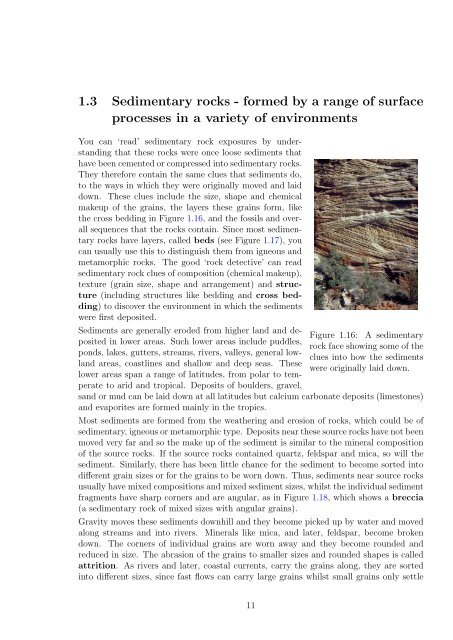The planet we live on: The beginnings of the Earth Sciences
The planet we live on: The beginnings of the Earth Sciences
The planet we live on: The beginnings of the Earth Sciences
- No tags were found...
Create successful ePaper yourself
Turn your PDF publications into a flip-book with our unique Google optimized e-Paper software.
1.3 Sedimentary rocks - formed by a range <strong>of</strong> surfaceprocesses in a variety <strong>of</strong> envir<strong>on</strong>mentsYou can ‘read’ sedimentary rock exposures by understandingthat <strong>the</strong>se rocks <str<strong>on</strong>g>we</str<strong>on</strong>g>re <strong>on</strong>ce loose sediments thathave been cemented or compressed into sedimentary rocks.<str<strong>on</strong>g>The</str<strong>on</strong>g>y <strong>the</strong>refore c<strong>on</strong>tain <strong>the</strong> same clues that sediments do,to <strong>the</strong> ways in which <strong>the</strong>y <str<strong>on</strong>g>we</str<strong>on</strong>g>re originally moved and laiddown. <str<strong>on</strong>g>The</str<strong>on</strong>g>se clues include <strong>the</strong> size, shape and chemicalmakeup <strong>of</strong> <strong>the</strong> grains, <strong>the</strong> layers <strong>the</strong>se grains form, like<strong>the</strong> cross bedding in Figure 1.16, and <strong>the</strong> fossils and overallsequences that <strong>the</strong> rocks c<strong>on</strong>tain. Since most sedimentaryrocks have layers, called beds (see Figure 1.17), youcan usually use this to distinguish <strong>the</strong>m from igneous andmetamorphic rocks. <str<strong>on</strong>g>The</str<strong>on</strong>g> good ‘rock detective’ can readsedimentary rock clues <strong>of</strong> compositi<strong>on</strong> (chemical makeup),texture (grain size, shape and arrangement) and structure(including structures like bedding and cross bedding)to discover <strong>the</strong> envir<strong>on</strong>ment in which <strong>the</strong> sediments<str<strong>on</strong>g>we</str<strong>on</strong>g>re first deposited.Sediments are generally eroded from higher land and depositedin lo<str<strong>on</strong>g>we</str<strong>on</strong>g>r areas. Such lo<str<strong>on</strong>g>we</str<strong>on</strong>g>r areas include puddles,p<strong>on</strong>ds, lakes, gutters, streams, rivers, valleys, general lowlandareas, coastlines and shallow and deep seas. <str<strong>on</strong>g>The</str<strong>on</strong>g>selo<str<strong>on</strong>g>we</str<strong>on</strong>g>r areas span a range <strong>of</strong> latitudes, from polar to temperateto arid and tropical. Deposits <strong>of</strong> boulders, gravel,Figure 1.16: A sedimentaryrock face showing some <strong>of</strong> <strong>the</strong>clues into how <strong>the</strong> sediments<str<strong>on</strong>g>we</str<strong>on</strong>g>re originally laid down.sand or mud can be laid down at all latitudes but calcium carb<strong>on</strong>ate deposits (limest<strong>on</strong>es)and evaporites are formed mainly in <strong>the</strong> tropics.Most sediments are formed from <strong>the</strong> <str<strong>on</strong>g>we</str<strong>on</strong>g>a<strong>the</strong>ring and erosi<strong>on</strong> <strong>of</strong> rocks, which could be <strong>of</strong>sedimentary, igneous or metamorphic type. Deposits near <strong>the</strong>se source rocks have not beenmoved very far and so <strong>the</strong> make up <strong>of</strong> <strong>the</strong> sediment is similar to <strong>the</strong> mineral compositi<strong>on</strong><strong>of</strong> <strong>the</strong> source rocks. If <strong>the</strong> source rocks c<strong>on</strong>tained quartz, feldspar and mica, so will <strong>the</strong>sediment. Similarly, <strong>the</strong>re has been little chance for <strong>the</strong> sediment to become sorted intodifferent grain sizes or for <strong>the</strong> grains to be worn down. Thus, sediments near source rocksusually have mixed compositi<strong>on</strong>s and mixed sediment sizes, whilst <strong>the</strong> individual sedimentfragments have sharp corners and are angular, as in Figure 1.18, which shows a breccia(a sedimentary rock <strong>of</strong> mixed sizes with angular grains).Gravity moves <strong>the</strong>se sediments downhill and <strong>the</strong>y become picked up by water and movedal<strong>on</strong>g streams and into rivers. Minerals like mica, and later, feldspar, become brokendown. <str<strong>on</strong>g>The</str<strong>on</strong>g> corners <strong>of</strong> individual grains are worn away and <strong>the</strong>y become rounded andreduced in size. <str<strong>on</strong>g>The</str<strong>on</strong>g> abrasi<strong>on</strong> <strong>of</strong> <strong>the</strong> grains to smaller sizes and rounded shapes is calledattriti<strong>on</strong>. As rivers and later, coastal currents, carry <strong>the</strong> grains al<strong>on</strong>g, <strong>the</strong>y are sortedinto different sizes, since fast flows can carry large grains whilst small grains <strong>on</strong>ly settle11
















